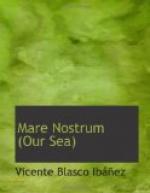CAPTAIN ULYSSES FERRAGUT
His first gallantries were with an empress. He was ten years old, and the empress six hundred.
His father, Don Esteban Ferragut—third quota of the College of Notaries—had always had a great admiration for the things of the past. He lived near the cathedral, and on Sundays and holy days, instead of following the faithful to witness the pompous ceremonials presided over by the cardinal-archbishop, used to betake himself with his wife and son to hear mass in San Juan del Hospital,—a little church sparsely attended the rest of the week.
The notary, who had read Walter Scott in his youth, used to gaze on the old and turreted walls surrounding the church, and feel something of the bard’s thrills about his own, his native land. The Middle Ages was the period in which he would have liked to have lived. And as he trod the flagging of the Hospitolarios, good Don Esteban, little, chubby, and near-sighted, used to feel within him the soul of a hero born too late. The other churches, huge and rich, appeared to him with their blaze of gleaming gold, their alabaster convolutions and their jasper columns, mere monuments of insipid vulgarity. This one had been erected by the Knights of Saint John, who, united with the Templars, had aided King James in the conquest of Valencia.
Upon crossing the covered passageway leading from the street to the inner court, he was accustomed to salute the Virgin of the Conquest, an image of rough stone in faded colors and dull gold, seated on a bench, brought thither by the knights of the military order. Some sour orange trees spread their branching verdure over the walls of the church,—a blackened, rough stone edifice perforated with long, narrow, window-like niches now closed with mud plaster. From the salient buttresses of its reinforcements jutted forth, in the highest parts, great fabled monsters of weather-beaten, crumbling stone.
In its only nave was now left very little of this romantic exterior. The baroque taste of the seventeenth century had hidden the Gothic arch under another semi-circular one, besides covering the walls with a coat of whitewash. But the medieval reredos, the nobiliary coats of arms, and the tombs of the Knights of Saint John with their Gothic inscriptions still survived the profane restoration, and that in itself was enough to keep up the notary’s enthusiasm.
Moreover the quality of the faithful who attended its services had to be taken into consideration. They were few but select, always the same. Some of them would drop into their places, gouty and relaxed, supported by an old servant wearing a shabby lace mantilla as though she were the housekeeper. Others would remain standing during the service holding up proudly their emaciated heads that presented the profile of a fighting cock, and crossing upon the breast their gloved hands,—always in black wool in the winter and in thread in the summer time. Ferragut knew all their names, having read them in the Trovas of Mosen Febrer, a metrical composition in Provencal, about the warriors that came to the neighborhood of Valencia from Aragon, Catalunia, the South of France, England and remote Germany.




